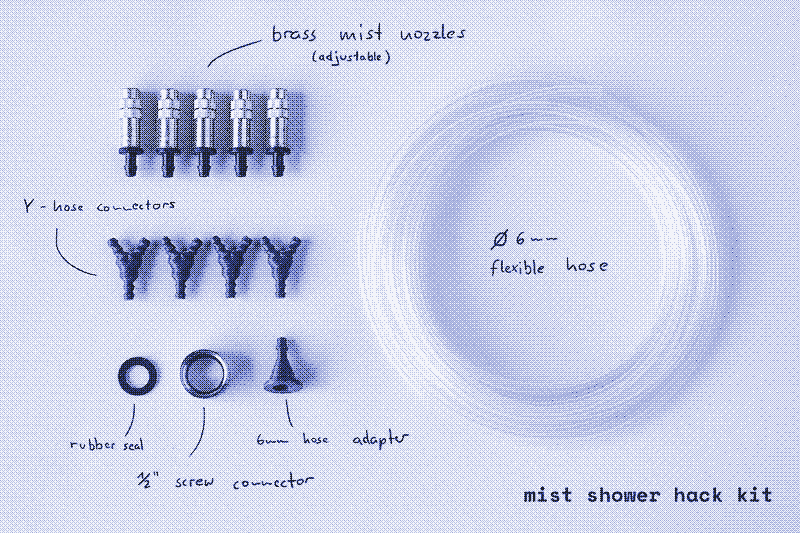
The daily shower would be hard to sustain in a world without fossil fuels. The mist shower, a satisfying but forgotten technology which uses very little water and energy, could be a solution. Designer Jonas Görgen developed a a-do-it-ourselves-guide kit to convert almost any shower into a mist shower and sent me one to try out.
The Carbon Footprint of the Daily Shower
The shower doesn’t get much attention in the context of climate change. However, like airplanes, cars, and heating systems, it has become a very wasteful and carbon-intensive way to provide for a basic need: washing the body. Each day, many of us pour roughly 70 litres of hot water over our bodies in order to be “clean”.
This practice requires two scarce resources: water and energy. More attention is given to the showers’ high water consumption, but energy use is just as problematic. Hot water production accounts for the second most significant use of energy in many homes (after heating), and much of it is used for showering. Water treatment and distribution also use lots of energy.
In contrast to the energy used for space heating, which has decreased during the last decades, the energy used for hot water in households has been steadily growing. One of the reasons is that people are showering longer and more frequently, and using increasingly powerful shower heads. For example, in the Netherlands from 1992 to 2016, shower frequency increased from 0.69 to 0.72 showers per day, shower duration increased from 8.2 to 8.9 minutes, and the average water flow increased from 7.5 to 8.6 litres per minute. 1
In many industrial societies it’s now common to shower at least once per day
Altogether, the average Dutch person used 50.2 liter of water per day for showering in 2016, compared to “only” 39.5 litres of water per day in 1992. This is a conservative calculation: these data do not include the showers taken outside the home, for example in the gym. Research shows that in many industrial societies, and especially among younger people, it is now common to shower at least once per day. 234

Taking the Dutch as an example, let’s look at the energy use and carbon emissions of a daily hot shower. Heating 76.5 litres of water (8.9 minutes x 8.6 litres per minute) from 18 to 38 degrees Celsius requires 2.1 kilowatt-hours (kWh) of energy. Depending on the energy source (gas, electricity), the carbon intensity of the power grid (US/EU), or the efficiency of the gas boiler (new/old), the resulting CO2-emissions of an average shower amount to 0.462 – 0.921 kg. 5 If we compare this to the carbon emissions of a relatively fuel efficient car (130 gCO2/km), the emissions of a typical shower equal 3.5 – 7 km of driving, and this result ignores the energy cost demanded by water treatment and distribution.
The emissions of a typical shower equal 3.5 – 7 km of driving
In principle, the energy for a shower could be generated by renewable energy sources. However, if eight billion people were to shower daily, total energy use per year would be 6,132 terawatt-hours (TWh). This is eight times the energy produced by wind turbines worldwide in 2017 (745 TWh). All (current) wind turbines in the world could provide only 1 billion people with a “sustainable” daily shower. Furthermore, the use of renewable energy sources doesn’t lower the water use of the daily shower. To be clear, renewable energy is part of the solution – solar boilers, biomass, heat generating windmills – but we also need to look at the demand side of washing in a post-carbon world.
More Powerful Showers
Since the early 1990s, low flow shower heads have provided a more water and energy efficient way of showering. These shower heads use between four and nine litres of water per minute, roughly half the flow rate of a normal shower (ten to fifteen litres per minute). Almost half of all Dutch households had a low flow shower head installed in 2016, but as we have seen, the flow rate of the average shower since the 1990s has been increasing, not decreasing. 1
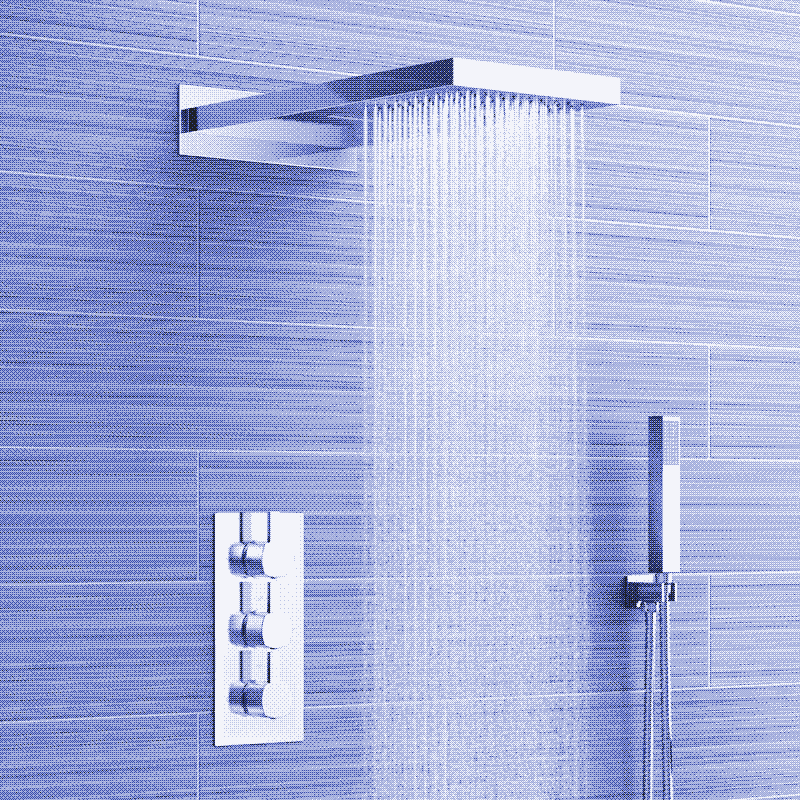
That’s because other Dutch people have upgraded to rain showers, which have a water flow of about 25 litres per minute – double that of a normal shower head, and three times more than what a low flow shower head uses. A 8.9 minute rain shower requires 222 litres of water and 6.3 kilowatt-hour of energy to heat it. The carbon footprint corresponds to 14.3 – 21.3 km of driving.
Life Before Showers
It may shock some younger readers, but only fifty years ago most people in industrial societies didn’t shower at all. Wall-mounted shower units, installed over the bathtub, became widespread only in the 1970s, and dedicated shower cubicles became a regular fixture in new homes only since the 1980s and 1990s. 234 Before the arrival of the shower, people took one (or a few) bath(s) per week, and in between they washed themselves at the sink using a washcloth (the so-called sink wash, bird bath or sponge bath).
The weekly water and energy use of a daily shower quickly surpasses the water and energy use of a once, twice or even thrice weekly bath
The shower is often presented as a more sustainable option than the bath, because the latter is said to use more water. However, the weekly water and energy use of a daily shower quickly surpasses the water and energy use of a once, twice or even thrice weekly bath. 2 The sponge bath is even more water and energy efficient: roughly two litres of water is sufficient to get clean, and the water could even be cold because not the whole body gets wet at the same time.
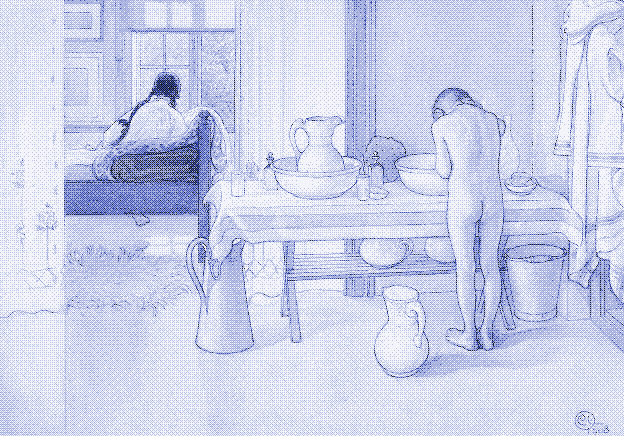
Environmental organisations, water companies, and municipalities encourage people in industrial societies to take shorter showers, use low flow shower heads, and install energy efficient water boilers. There’s also factors influencing energy and/or water use that these institutions don’t dare to question: shower frequency, water temperature (“take cold showers”), or the act of showering itself – it is never suggested that a sponge bath would actually suffice. Clearly, the daily hot shower is today regarded not as a luxury but as a basic necessity.
Why Do We Shower?
However, showering does not only wash the body. A shower that’s entirely focused on cleaning the body – a so-called Navy shower or Sea shower– takes very little time, energy and water. A Navy shower consists of a 30 seconds shower to get wet, soaping the body while the water is off, and is completed by another 30 second shower to rinse the soapy water.
![Until the 1970s, showers were only used in barracks or prisons to wash many people in a short time. [^2] Image: La douche au Régiment, a painting by Eugène Chaperon, 1887.](https://solar.lowtechmagazine.com/2019/10/mist-showers-sustainable-decadence/images/dithers/showers-soldiers_dithered.png)
Assuming an average water flow, a (hot) Navy shower uses only 8.3 litres of water and 0.2 kilowatt-hour of energy. A daily sponge bath would have even lower water and energy use. A nine minute hot shower per day is by no means a basic necessity: it’s a treat. Since the 1990s, the daily shower has been portrayed in advertisements as a means of relaxation, stress relief, and sensual pleasure. 24
Mist Showers
The use of the shower to treat oneself seems to be incompatible with a drastic reduction of its water and energy use. However, there is a technology that might just do that: the mist shower. A mist shower atomizes water to very fine drops (less than 10 microns), which greatly reduces the water flow. Buckminster Fuller invented the first one in 1936 as part of his Dymaxion bathroom (he called it a “fog gun”). The idea was taken up again in the 1970s, when several trials and experiments were conducted with both atomised hand washing and showering.
![Left: Mist shower developed by NASA. Right: Mist shower developed by the Canadian Minimum Housing Group. Both are from the 1970s. [^7]](https://solar.lowtechmagazine.com/2019/10/mist-showers-sustainable-decadence/images/dithers/mini-mister_dithered.png)
NASA developed a mist shower with a hand-held, movable nozzle that incorporated an on-off thumb controlled water valve attached to a flexible hose. The average water use for a nine-minute shower was measured to be 2.2 litres, which corresponds to a water flow of only 0.24 litres per minute. 6 The Canadian Minimum Housing Group developed and tested several mist showers and obtained a flow rate of 0.33 liters of water per minute. 7. In both cases, swab tests of bacteria on the skin showed that mist showers clean the body just as well as a “normal” shower of the same duration – using 30 to 40 times less water.
Jonas Görgen developed a kit that converts almost any shower into a mist shower.
Jonas Görgen, a young designer who graduated from the Design Academy Eindhoven in 2019, became fascinated by the history of the mist shower and decided to build one himself. Compared to earlier mist showers, Görgen has improved the concept in two important ways. First, he developed a kit that can turn almost any shower into a mist shower with very little effort. Second, in contrast to earlier experiments, his mist shower uses not one but three to six nozzles. This turns a functional but very basic mist shower (using only one nozzle), into a pleasant experience that feels just as comfortable and invigorating as a “normal” shower.
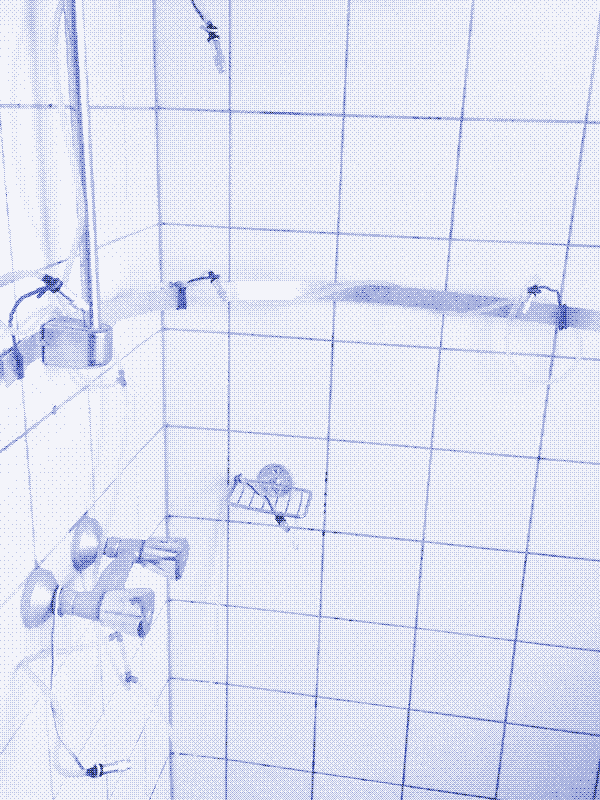
The kit that Jonas sent me contains six nozzles, some connectors and dividers, some flexible plastic tubes (“feel free to cut to any length”), and some pieces of copper wire (“to fix and attach the nozzles in the right positions”). I installed a five-nozzle mist shower in less than twenty minutes, and although the result won’t win a design award (in fact, Jonas built a more beautiful mist shower for his graduation project), as a a-do-it-ourselves-guide shower hack it is simply brilliant.
With five nozzles, I measured a water flow of two liters per minute, which is five times less than my now obsolete shower head
In my set-up, four of the nozzles are fixed (one aimed at the head, one aimed at the back, and two aimed at the hips), while one is flexible and can be aimed where it’s needed – as in the NASA experiments. Using more than one nozzle increases the water flow, but the water savings remain significant.
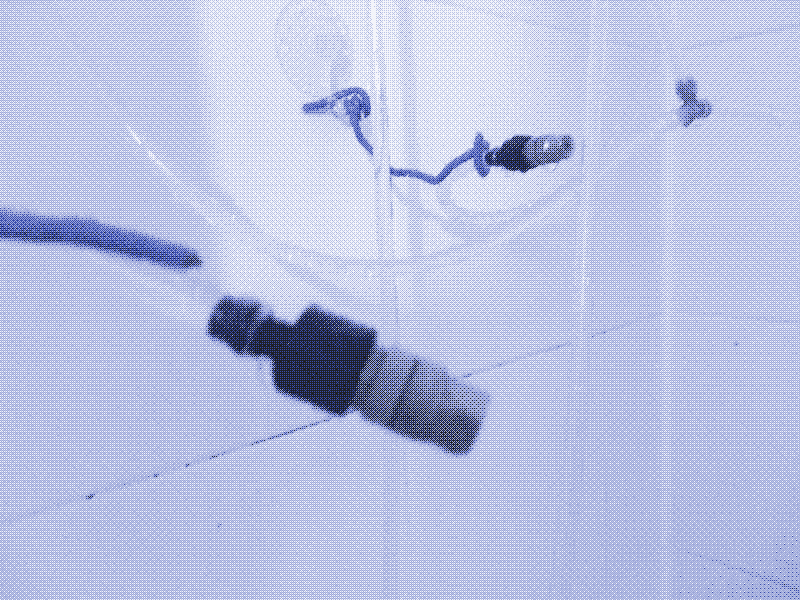
For five nozzles, I measured a water flow of two litres per minute, which is five times less than my now obsolete shower head (ten litres per minute) and 12.5 less than the water flow of a rain shower. It’s unusual to obtain such large savings with so little effort. Jonas writes about his shower that “it is not all a compromise in comfort, as it is sometimes suggested in the research papers of the 1970s” and I totally agree. The difference is clearly due to the fact that earlier mist showers only used one nozzle.
Energy Savings of a Mist Shower
The energy savings of a mist shower are smaller than its water savings. That’s because a mist shower requires a higher water temperature. The increased surface area of the water decreases water use but also causes the heat to dissolve more quickly in the air. Even if the water coming from the tap is at maximum temperature (usually 60 degrees Celsius and already slightly too hot to touch), when sprayed by a nozzle it quickly loses its temperature the further you place your body from the opening. The trick is to position the nozzles in such a way that they closely surround the body. I did this with the iron wires and some duct tape, but there are more elegant ways.
The energy savings of a mist shower are smaller than its water savings
I found a water temperature of about 50 degrees Celsius to be sufficient for thermal comfort, but a mist shower in winter may require a higher water temperature, so let’s assume a value of 60 degrees to calculate the energy use of my 5-nozzle mist shower. At a flow rate of two litres per minute, a 8.9 minute shower consumes 17.8 litres of water. Heating that volume of water from 18 degrees to 60 degrees requires 1.04 kWh. That’s half the energy use of the average shower in the Netherlands (2.1 kWh), and six times lower than the energy use of a rain shower (6.3 kWh).
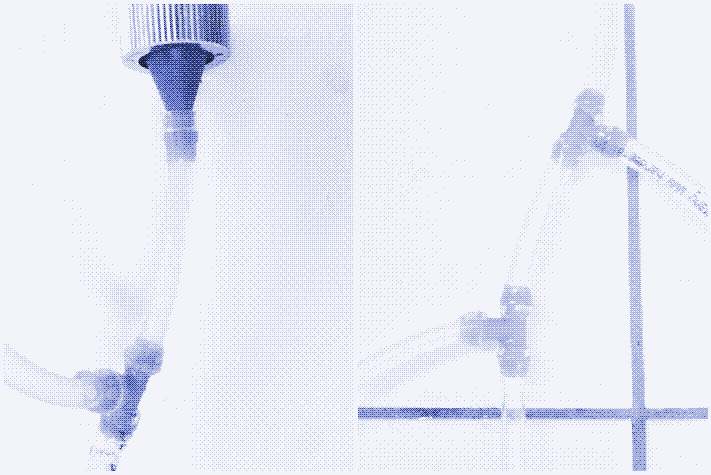
The energy use of a mist shower could be further reduced by showering in an enclosed cabin, which increases thermal comfort with lower water temperatures. Another trick to increase thermal comfort in winter is to open the nozzles a bit so that the surface area of the water decreases. This increases water use but decreases heat loss. It is down to the individual to find balance between saving energy or water, based on local circumstances.
An argument that is often made against water saving shower heads is that people compensate lower water flows by taking longer showers. A similar argument could be made against mist showers, because the use of mist increases the time needed to rinse the body of soapy water. However, a mist shower of 8.9 minutes offers plenty of time to get rid of soap and shampoo. The test subjects in the NASA experiments all managed to wash and rinse within 9 minutes, using only one nozzle on a flexible hose. Washing long hair is more problematic, but also in this case the problem can be addressed by opening the nozzles a bit more, increasing the water flow.
How Many Nozzles Can We Afford?
The five-nozzle mist shower offers significant water and energy savings compared to a “normal” shower and does so without sacrificing comfort. However, is it sustainable enough? If eight billion people used a five-nozzle mist shower, all wind turbines in the world could still only provide two billion people with a daily hot shower. And, compared to a one-minute Navy shower – which is entirely focused on efficiency, not on comfort – energy use is five times higher, and water use is twice as high. So, let’s see what happens when we decrease the number of nozzles, still assuming average shower frequency and duration.
Three nozzles – with a flow rate of roughly one liter of water per minute – are the minimum for providing the comfort of a hot shower
I found three nozzles – with a flow rate of roughly one liter of water per minute – to be the minimum for providing the comfort of a hot shower. This would bring the water use of a 8.9 minute mist shower down to 8.9 litres, which corresponds with the water use of a one-minute Navy Shower. The energy use would come down to 0.52 kWh, two to three times higher than that of a Navy shower. This would provide four billion people with a wind-powered daily hot shower, meaning that if we halved the shower duration (from 8.9 to 4.5 minutes) or showered less frequently (once every two days), the global population could be cleaned and pampered using only wind power.
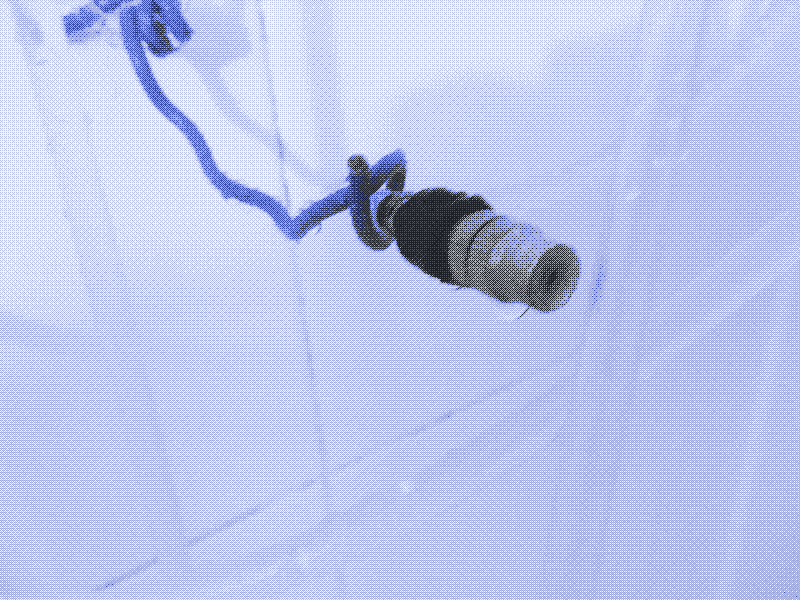
If we give up on comfort and simply get clean with as little energy and water as possible, we could take a mist shower using only one nozzle, just like in the seventies. Using just one nozzle I measured the water flow to be 0.3 litres per minute, meaning that a 8.9 minute mist shower would need only 2.67 litres of water and 0.156 kilowatt-hour of energy. The resource use of a mist shower then corresponds to that of a sponge bath, and is significantly lower than that of a one-minute Navy Shower. All wind turbines in the world could provide roughly 15 billion people with a daily 8.9 minute hot mist shower.
If more than fifteen nozzles are used, the energy use of a mist shower is higher than that of a conventional shower
Conversely, the water and – especially – energy use of a mist shower increases quickly as more nozzles are added. With twenty nozzles, the water use is still below that of the average shower (6-7 litres vs. 8.3 litres per minute), but the energy use is already higher: 3.1 kWh compared to 2.1 kWh. With ten nozzles – see for instance the commercially available Nebia Spa Shower – water use remains very low at only 3 liters per minute, but energy use is only 25% lower in comparison to a normal shower (1.45 vs. 2.1 kWh). Mist showers are not low energy products by definition. It depends how we use them.
Off-Pipe
There’s one problem with mist showers operating with only one to three nozzles: modern water boilers don’t get triggered by a flow rate below 1 litre of water per minute, meaning that only cold mist comes out. This is not a fundamental problem – it’s technically possible to make water boilers that heat small amounts of water – and it brings us to another potential advantage of the mist shower: its effect on the bathroom.
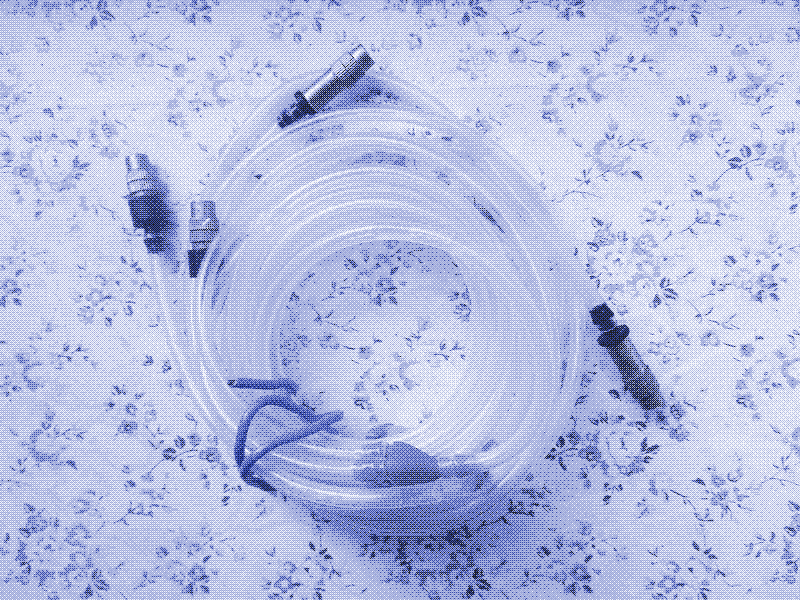
The modern shower is not a device that stands on its own. It is plugged into several infrastructure networks, like the water supply, the sewer network, and the power grid or gas infrastructure. In contrast, although a mist shower could be plugged into the same infrastructures, it could also operate without them, further reducing the use of resources.
Modern water boilers don’t get triggered by a flow rate below 1 liter of water per minute, meaning that only cold mist comes out
First of all, a switch to mist showers would make it possible to use much smaller and less powerful water boilers, which could be powered by local solar or wind powered systems that are smaller and cheaper than those required for conventional water boilers. With a minimal mist shower, one could even question the need for a water boiler at all. The quantity of water is so small (2.67 litres) that it could be heated on the fire – just like in the old days.
![A portable mist shower from the 1970s, pressurized with a bicycle pump. [^7]](https://solar.lowtechmagazine.com/2019/10/mist-showers-sustainable-decadence/images/dithers/1970s-portable-shower_dithered.png)
Secondly, because of its high water use, a conventional shower needs to be connected to the drain. The mist shower discharges much less water, which makes it possible to take the shower off-pipe and treat the water on site, for example to flush the toilet, water the plants, or clean the pavement. Third, a water supply in the bathroom is not strictly necessary either: a small container could be filled elsewhere and taken to the bathroom.
The Canadian experiments in the 1970s resulted in such a portable mist shower. The water was stored in a Volkswagen window washing reservoir connected to a bicycle pump to pressurize the water. The 2.5 litres of water were pressurized with about twenty strokes of the bicycle pump. 7 In short, if we switch to mist, the infrastructure that made the modern shower possible can be scaled down and simplified, to such an extent that the bathroom could be taken off-grid and off-pipe even in an urban context, bringing further reductions in the use of water and energy. The same approach could be applied to hand washing and dish washing.
Jonas Görgen’s mist shower is not for sale yet, but you can let him know if you’re interested. A mist shower is on display at the Dutch Design Week Eindhoven, 19-27 Oct. 2019.
Please note that all showers carry a legionella risk. The smaller water droplets from a mist shower remain in the air for a longer time, which increases the risk of inhalation. Therefore, it is important to take elementary precautions.
Reactions
To make a comment, please send an e-mail to solar (at) lowtechmagazine (dot) com. Your e-mail address is not used for other purposes, and will be deleted after the comment is published. If you don’t want your real name to be published, sign the e-mail with the name you want to appear.
Reactions
Mark
Looking at a) the length of the shower, b) the amount of water used, and c) the amount of energy used to heat the water…
I have found that I’m more inclined to take longer, hotter showers once it starts cooling off outside. Lingering in a hotter shower warms me.
It also dries my skin out terribly in the winter time, leading me to seek selfish methods for taking a shorter, cooler shower.
I’m also a bit paranoid about steam/condensation/moisture in my bathroom, and any detrimental effects on my home. (Mold, etc.)
The latter gives me some pause with a mist shower. The more the water is atomized, the more of it is staying in the air, settling on surfaces, rather than going down the drain.
As for the length & water temperature factors, I’ve found that heating the bathroom to be warmer than the thermostat temperature, by turning on a ceramic fan space heater ahead of time, accomplishes a number of things for me:
It dries out the air in the bathroom, leading to less condensation on windows, mirrors, etc.
It puts me in a warm space, where I can comfortably turn the shower to a lower temperature, and get in and out faster.
This approach reminds me of one of the earliest posts I encountered on Low-tech Magazine, outlining localized heating options that heat the immediate space around a person rather than the entire available space in the structure.
Combining a low-flow shower head or mist shower with a warmer bathroom might be even more efficient, though I have some reservations about the long-term effects on the structure from the mist shower. I find that warming the environment the shower is in helps greatly, too.
Ryan Shepard
The link to let Görgen know we’re interested looks to be broken.
Joshua Spodek
I predict that future generations will look at rain showers not with envy at the self-indulgence but with disgust at lack of compassion for others.
Mist showers look like a way forward. It’s refreshing to have a consistent source of perspective and paths forward that isn’t just putting the word “green” or “recyclable” on it so they can sell more.
J.M.C.S.
Reading the finishing paragraph of this article, I suddenly realized why the problems of using mist showers sounded so familiar (requires higher temperature, etc): I, and other campers, have been taking “mist showers” for a while now. We use pressurized garden sprayers to do so.
In fact, when I moved to my current apartment last winter and we didn’t yet have electricity, the problem of the temperature become sharply evident :). In the end we took sponge baths for a while.
Another alternative for showering: Solar (consisting of a black plastic bag and a nozzle) camping showers. The 12 liters ours hold are way more than enough for my partner and me to get clean, and the pressure is all gravity produced. We just need to plan our showers a bit carefully and lay the bag in the sun to warm up.
Kelly
Sounds interesting, I may give it a try. Unfortunately your recommended water temperatures would present an obstacle in the USA, where we have been told that any temperature above 49C will strip the flesh right off of your bones. As a result our building codes require installation of valves which limit water temp to 49C or lower.
kris de decker
@ Alejandro
I would not count on it.
Steve
This absolutely is a Legonella risk -and I should know as I spent a week in hospital with it and a three month recovery period afterwards - caught from inhaling water droplets from a modern and well equipped marina shower while on a sailing trip. I would not wish what I went through on anyone, collapsed lungs are extremely unpleasant.
A previous respondent misquoted a Wikipedia page regarding temperature control to eliminate the bacterium. Duration of temperature is also an important factor. The correct information is as follows
Temperature affects the survival of Legionella as follows:
Above 70 °C (158 °F) – Legionella dies almost instantly
At 60 °C (140 °F) – 90% die in 2 minutes (Decimal reduction time (D) = 2 minutes)
At 50 °C (122 °F) – 90% die in 80–124 minutes, depending on strain (D = 80–124 minutes)
48 to 50 °C (118 to 122 °F) – can survive but do not multiply
32 to 42 °C (90 to 108 °F) – ideal growth range
25 to 45 °C (77 to 113 °F) – growth range
Below 20 °C (68 °F) – can survive, even below freezing, but are dormant
Other temperature sensitivity[29][30]
60 to 70 °C (140 to 158 °F) to 80 °C (176 °F) – Disinfection range
66 °C (151 °F) – Legionella dies within 2 minutes
60 °C (140 °F) – Legionella dies within 32 minutes
55 °C (131 °F) – Legionella dies within 5 to 6 hours
Juan Marcos
Great idea, great analysis ! At least in Spain water mist systems are frequently installed in “terrazas” (open air bars); these have been associated to an increased risk of airborne transmission of Legionella. When I built my own thermal solar system here in Brussels, I was advised to 1. keep the water temperature of my solar water tank well above the temperature required for a shower (Legionella will not survive 90 degrees) and 2. let the water run before taking a shower after coming back from holidays. May I suggest an update of the text taking into account this potential risk ?
John A
Great article as always!
I have pointed this out to my familiy as well in the past. My family is 1 wife, and 2 daughters. They all have long hair, they all shave in the shower. A mist shower is simply not powerful enough to rinse long hair of soap and conditioner. A combination of the 2 might be a win.
Thanks for your valuable insights!
Andy
Is soap necessary or healthy?
Several years ago my daughter told me she didn’t use soap as she had read on a beauty website that this was bad for the skin. I tried it and haven’t used soap since. Well only for washing my hands if they get dirty grease from the car.
It makes sense. Your body makes oil to put on the skin and then we use a poisonous chemical(soap) to wash it off. Your body then goes into overdrive to replace it. If you try it you will find you actually smell less.
I also stopped using chemicals(deodorants) to stop me smelling. The smell emanating from your armpits is caused by dead bacteria so I kill the bacteria using lemon juice. I simply take a piece of skin from an already squeezed lemon and rub it in my armpits. The effects last about 3 or 4 days, after which the bacteria start to recover and you need to do it again. Don’t do it everyday as it will start to irritate the skin. Unfortunately it doesn’t give you a nice lemony smell. There is just no smell at all. I presume vinegar would also work but haven’t tried it.
Rafael Ospino
Jim Baerg - No, there is no safe lower temperature, and the safe disinfection temperature is 90 degrees Celsius. 25 to 50 degrees is the optimal cultivation temperature range. Below 25 it just grows more slowly. And the dirtier the water, the greater the risk. The only method to make a shower like the one described completely safe is to flush water with a temperature of 90 degrees with all nozzles covered with plastic bags in order not to allow the formation of aerosols. The flushing must continue until all parts of the construction have reached 90 degrees.
This procedure is the correct one for all type of showers, not only mist showers.
Please Jim, do not trivialize the risk. Even if Legionella is fatal for only 10-20% of the cases many of the survivors are subjected to lifelong suffering, including risk for paralysis.
In warm countries it is vastly safer and water saving to leave a water of bucket in the sun and then just scoop it over you. That will produce very little or none of the lethal mist or aerosols.
Thanks for informing about the outdated info on Wikipedia. I shall correct it as soon as possible.
Jim Baerg
“If eight billion people used a five-nozzle mist shower, all wind turbines in the world could still only provide two billion people with a daily hot shower.”
But most of the worlds population lives in the broad band either side of the equator where there is enough sunlight even at the winter solstice to make solar water heating practical.
Re: Legionella
The Wikipedia article on the bacterium says that keeping water cooler than 25 °C or hotter than 51 °C, is one way to make sure Legionella dies.
Josephine Ferorelli
This brings to mind another shower-style that is more common in water-scarce places, the bucket shower. No special equipment needed: bucket, cup, and appropriate location. I showered this way consistently when I was traveling in North India: when I was lucky, a guest house would be able to deliver a hot bucket. I guess it’d be a tougher sell than something based on familiar hardware, but I found that I quickly got used to it, and even when ambient temperatures were pretty low, a bucket of hot water was enough to feel warm, clean and cozy. Especially in a small, enclosed space. Hair rinsing was easy, and the water stayed hot for the full length of the project. Much depends on how you heat it, I suppose.
Best, and thanks for your ongoing project,
Josephine
JuliusJ
Hey
Thanks for the article. There is one technical detail in the beginning. Please prove me wrong, but when i calculate the energy needed to heat 76.5 liters of water from 18°C to 38°C, i get another result. I approximate the density of water with 1kg/l, the temperature difference is 20 Kelvin and the heat capacity of water is roughly 4.2 kj/ (kg*K).
So 76.5 kg * 20 Kelvin *4.2 kj /(kg *K) = 6.426 *10^3 kJ
1kWh = 3600 kJ, so i divide the result by 3600 and get 1.785 kWh, approximately 1.8 kWh. You wrote that it would be 2.1 kWh, so i wonder where is the mistake.
Sigrid
Hello,
Thank you for posting this article. It is quite timely considering the recent droughts in the western USA. In 2015, Washington State experienced a severe drought. I was amazed and shocked to see Lake Cle Elum, also a reservoir, reduced from a large lake with waves in a brisk breeze, to a narrow stream with “dust bowls”. The state and municipalities asked residents to voluntarily reduce water use 10% or face mandatory restrictions. Seattle residents reduced their water use 15% in response.
Deciding to do our part, we switched the washing machine and dishwashers to the quick cycles already on the machines and discovered that nearly everything came clean just as well as with longer cycles.
We also switched to low flow shower heads, and I substituted sponge baths for showers 3-4 days per week. My skin became less dry, an unexpected benefit of showering less.
We saved water from sinks and bathing to flush the toilets, and waste water from the washing machine to water landscape plants, although not vegetables for food safety. I hooked up the effluent hose from the washer to a rain barell, attached a water hose to the tank and watered plants while the machine was running.
The result is that we dropped our household water use by 45%. Our water bill also dropped by 40%, so we saved a lot of money. We have maintained these conservation efforts since then and I estimated that we have saved enough water to fill an Olympic swimming pool and several thousand dollars. We did this with no change in available technologies and no drop in quality of life. We did not imagine that conservation alone could do so much!
Thanks again,
Sigrid
Ruben
I am super excited about this, because I have been collecting parts to experiment with mist showers (which along with an enclosed shower stall, should be a very lovely experience).
As for rinsing, I have been basing my thoughts on the common shower valve that is used to switch between the wall-mount showerhead and a handheld. In this case, it would switch between wall mount for rinsing and mist for long warmth.
djargo
great article!
never knew about sponge bath, will give it a try. been using the navy shower, though i didn’t know it was called that.
mist showers are such a cool idea, very fitting that it was fuller who built the first.
if they become widespread (as they should), sewage systems will need a serious overhaul because they are designed around higher water usage. they will be damaged in their current state.
https://www.watereducation.org/western-water/californians-save-more-water-their-sewers-get-less-and-thats-problem
it is also a known problem when upgrading an old house with new water-saving equipment, but keeping old drain piping.
there is a minimum amount of water needed to reliably transport solid matter (e.g. shed skin) and a certain amount of hot enough water to prevent grease buildup (e.g. from soap).
what kind of solutions exist for this?
karl
A few years ago my water heater failed. To get warmed water, I put a black plastic bucket into a large clear plastic bag. It worked. A few days later I built a plywood box with a clear plastic cover. I put castors under it to ease aiming it to the sun. It worked much better.
To see this assembly, go to Gary’s www.builditsolar.com web site and look at the water heating section where he has an article about this water heater.
4 gallons of heated water was more than enough to pour over me and get clean.
Sylvain
I don’t spend 8 or 9 minutes with the water running. When wet, I stop water and apply real soap. Then I rinse myself. It must be 2 or 3 minutes with the water running.
Shower gel are made to be applied with the water running and so are made sticky. Then shower gel needs much more water than the soap to get rid of it.
IMHO shower gel are a nonsense. Most of it goes to the drain without producing any washing effect. It is a waste of resource.
Sylvain
Jörgen
no, i don’t believe in it. maybe we just stop being under the shower so long. i tried the spray several years ago. and like they said. you need to boost up the temperature a lot. if you move a lot in the shower like me, the difference between too hot (like they said 50°) and good enough are bigger than in a normal shower. definitely the ones that are on the sides of the shower.
maybe a recovery system would be more something i believe in. which can partly reuse the temperature of the water running away in the drain. or even the water itself.
no, i don’t believe in the spray. small chance of breakthrough in my eyes.
Vicente Baca
It seems like the “Navy shower” has about the same efficiency, does not require new hardware, and does not incur the risk of bacterial infections.
I intend to make this my routine now. Thank you for introducing me to it.
finn
Thanks for the article! Reminds me of our garden pressure sprayer, that you can easily charge by hand. I’ll give it a try at my next shower :)
https://www.agritek.de/haus-und-hof/gloria-prima-5-druckspruehgeraet_981003_3254
zanetta
Just don’t take a shower everyday. The more you wash your skin and hair the more they suint sebum. If you stop to take shower everyday, they adapt themself after a short time of 1 month maybe. I personaly take 1 shower every 3 days or after sports. My transpiration smell is also lighter. If I don’t take shower as while camping holiday for more than 3 days I don’t smell. If necessary and for more comfort you can make a sponge cleaning. The best way to save money and energy is to question needs before technology.
Mario Stoltz
Hello Danica (28),
I guess the classical bits of advice would be:
consider “sink bathing” in the shower stall
get as close to the floor as you can - this will limit the range of spills. In many countries in the middle east, people wash on short-legged stools for this reason (sitting about 20cm or 8in above the floor). This also means that you will take your water from a bucket or a washing bowl, not the sink itself
make a few trials with how strongly you wring your washcloths out before you use it on your body. It does not have to be dripping-wet to clean your skin.
James Newton
One thing he did NOT cover was using a heat exchangers to recover heat from the drain water to help warm the incoming. I can also tell you that Navy showers work very very well. And if you have a nice blast of warm /air/ on you, they are quite comfortable. Heating air is far more efficient.
Danica
I’d love to switch to primarily sink-baths, BUT one thing I can’t figure out is how to do it without getting water all over the floor and annoying my housemates. I could lay a towel down and then mop up the floor with it afterwards, but it wouldn’t dry in time to use the next day (my regular shower towel is always still slightly damp the next day, so a towel that had absorbed more water wouldn’t dry at all). I’d have to use a new towel every day, and at the end of the week I’d have a whole extra load of musty towels to wash and dry, which is more water and electricity than 2-3 showers.
There has to be a better way to do it without getting water everywhere, but it seems to be one of those things that was such common knowledge at the time that no one wrote down how to do it, and now no one remembers. I can’t find a description of how to properly sink-bathe with minimal mess anywhere, except to do it outdoors where the water just falls on dirt - not very helpful. Has anyone else troubleshooted this and figured out how to do it?
Mike A
Too complicated for me. I prefer a daily sponge bath with a barely damp washcloth: face, neck, armpits, and crotch. And then a weekly shower with a ‘Navy’ type shower head, which lets you wet down, then easily stop the flow to soap up, then restart the flow to rinse. I take less than 30 seconds to wet down, and no more than one minute to rinse. So maybe 12 to 15 litres max per week
My big waste of water and energy is with shaving. I use much too much hot water there. Which is why I only shave once a week, but I’m retired so can get away with it. Never found an electric razor that gives a clean shave. I’m 76 and have been looking for a good one most of my life.
RJochim
Hello Kris,
I already used a water saving shower head. Your article inspired me to
further reduce the consumption simply by replacing the little
perforated plastic disk in the shower head with a home brew version. A
new disk, cut out of an old plastic container and perforated with a
hot needle, has much smaller holes now. That creates finer droplets
and considerably reduces the water flow.
I do have the same concern as the person in comment 18 though. Much of
the water goes into flushing down the soap residues after showering
(or taking a sponge bath). Otherwise the pipes get clogged quite quickly.
So far I have no solution other than pouring down the pipes hot water
or applying chemical treatment from time to time with vinegar and
sodium bicarbonate. I may have to get a drain snake for mechanical
cleaning but they take up storage space in a small home.
If you have any advice, updating the article might help many readers
of your website.
Thank you very much for your work and have a good weekend.
atyh
Kris,
I’ve been thinking about this mist shower concept off and on for a while now, and am thinking about using a stainless steel hand pump gardening sprayer as the pressure unit. Heating of the water would be in a large pot, on a small rocket stove. Finding the proper fittings to fit it all together is the trick…
✟♡
atyh
danielle
i take sink baths using green tea or an herbal tisane, using only a few cups of water. no need for soap. i wash my hair over the tub or kitchen sink with bar shampoo, avoiding plastic packaging.
Gabriel
Micron Woman - Guide to the world spray droplets
https://www.youtube.com/watch?v=EMJu6n8r5Us
Kevin
Great idea and I’m glad you’ve posted it. The history was interesting as the pre-1990’s world is a mystery to my lived experience.
I.
I had a thought to improve it and to increase acceptance by using a mixed approach - plus to avoid legionnaire’s disease.
If the system could be designed such that a single switch/level near the water controls could alternate the nozzles from flow to mist. This would allow for flushing and warming of the nozzle lines and would support more usage patterns.
In effect it would be like a combination ‘Navy Shower’ with quick flushes, while tuning down to the mist mode while you’re soaping up and ‘feeling luxurious’ by standing in the water. The flushes would be essential for long hair and quick final rinse offs.
II.
Another great water saver I’ve not seen in many places is in the kitchen. There are foot operated controls which allow you to turn the water on/off while using both hands to hold the dish and the sponge. Huge amounts of water are wasted while washing up because it is too hard to constantly turn the flowing water on and off. People frequently use lots of energy intensive hot water when washing up. It is a little more complicated to install and use, but once you get past that, the foot controls quickly become essential!
Eric Brozell
This is the first article that I have read on Low Tech Magazine. In fact, I just discovered it’s existence this week.
What an amazing and thorough article this was. This Magazine and type of stories will be the savior of life as we know it.
Thank you.
L3140
Hello everyone,
Thanks a lot for this very interesting article !
I have been trying to do the same system at home, I have one technical issue, I can’t find the parts to make the adapter that allows to connect the existing installation to the 6 mm tube, would you have any advice ? I searched for the parts and already made adapters, I didn’t succeed, I suppose I am not looking in the right places, I just don’t know where to look.
Have a nice day
Laurent
Alejandro
In my country the water is Chlorinated to kill bacteria. Does that counts to kill Legonella?
Sonya
Thank you for yet another v interesting and thought-provoking article, and to all the people who made constructive comments.
A few thoughts :
I loved the mist shower idea but have harkened the warnings about legionalla - love Kevin’s idea of switching from water flow to mist to water flow, plus ideas about putting a cover on the shower, blasting warm air to help feel warm on cold days and solar heating a bucket of water;
My modern boiler heats to over 90° once every 24 hrs to kill legionalla bacteria. But we space out our showers and I didn’t know you had to rince out taps & pipes.
Sponge washing doesn’t have to be wet but if it is, doing so in the shower can be handy (as can not having taken out the bidet from your 70’s house)
Thanks for the idea of using green tea or herbal tisanes to sponge wash, I use them as a hair rinse but hadn’t thought to do so to replace soap, which is indeed much better than shower gel but effectively just as damaging to the skin, as is chalky or chlorinated water. Apart from washing less often, using oils and creams(ALL over, and even while still damp) protects skin. For the underarms, if sweat smell is likely to be a problem, bicarbonate works as an alternative to lemon juice (but I’ll try herbal teas, too)
The most economical for washing dishes is to pre-rince, then use a bowl of hot washing water and a bowl of cold rinsing water with a dash of vinegar in it. Change the washing water when it gets too greasy.
And thanks to the person who gave all the water saving tips !
oitdart
I live in Brazil and recently I bought what people here call “redneck shower” http://images.tcdn.com.br/img/img_prod/662859/233_9_20181012101648.jpg
With 2.5 liters I can take a shower, as well as my son. My wife takes 5 liters total to include washing her hair.
To heat 2.5 liters of water from 25 to 40 C it is necessary 4 min and 20 seconds at a 1000W stove, wich is roughly 9 KWh (maximum) per month.
Numbers may vary by place and by family, but it is a great reduction of water and energy consumption.
gr8bkset
My water utility in Southern California gives out low-flow showerheads that can dial to 2\4\6 litters per minutes and has a cut-off switch. My showers at 2 lpm typically goes through 10 liters. I capture the non-soapy water to flush the toilet. Although the shower is directly above the water heater, at the start I need to flush 4 liters before it becomes warm. I catch this clean flush water in a bucket to wash my daily underwear, then use that soapy water to mop the floor and then finally to flush the toilet. In the Summer, I take cold showers which uses as little as 4 liters without needing to wait for warm water. My daily water consumption is around 40 liters which is one-tenth of an average American. It takes 2-3 months for my water meter to move one tick. Unfortunately this doesn’t save me much money because most of my $35 water bill goes to “water conservation” measures for the utility. I conserve because water is essential to life and hopefully whatever I don’t consume remains in nature and supports additional wildlife on our planet.
Ben Brown
Kris, A year after using a single nozzle and agricultural sprayer after reading your article on mist showers, I invested in mist heads, a hose an on/off valve and a better sprayer tank/pump. I can not say enough good about a low impact mist shower. I’ve been journaling/e-mailing our local college contact and the city’s sustainability officer in Kalamazoo, Michigan for the past three weeks. I’ve collected data which I hope to get corroborated. In brief: I heat 1.5 gallons of filtered/purified water to 148F in 16 minutes on an induction hob set for 700 watts of energy. The water is poured into the tank which is plumbed to 2 mist heads, one hip height, the other just above my face. Getting wet/shutting off the water/soaping up/rinsing off I use 1 gallon of water for the total shower. The sensation is far better than using my 1.5 gpm showerhead and I feel both warmer and cleaner. I wish there were several advocacy groups promoting this as a superior experience. I definitely plan to talk about this far and wide. It is a cultural turn from the more we consume the more satisfied we will be but it can be fully a valid thing.
Thomas W
https://www.icecoldmist.com/personal-bottle-mister-original.html
I use something like that in my tiny house. 5$ from the dollar store. I mainly use it with a 25% white vinegar solution, works very well for cleaning all kinds of things: counters, dishes & humans! Works with warm water as well but I prefer a steaming hot washcloth. Either way, water consumption is less than a cup per wash.